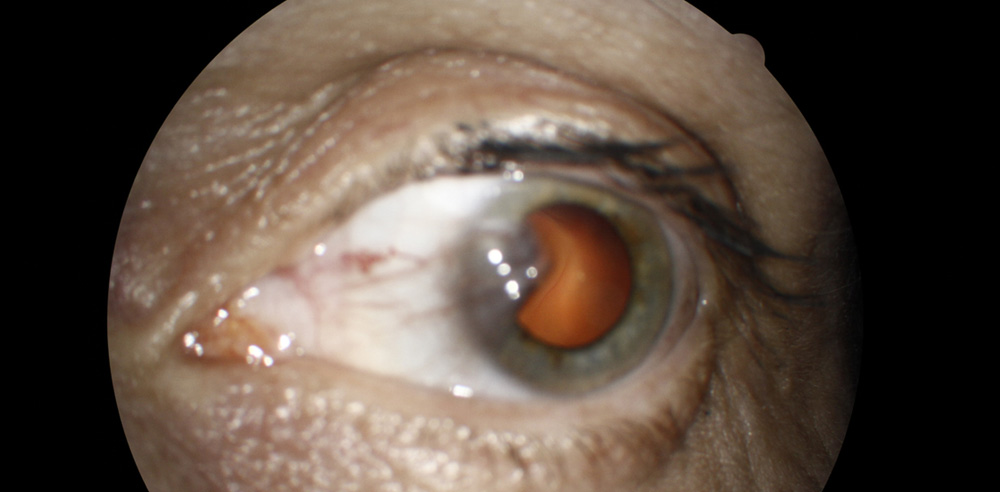
A Pterygium is a fibrovascular, benign growth on the front surface of eye. It is thought to occur from long term sun exposure.
A pterygium is a non-cancerous growth which grows from the white “skin” (conjunctiva) on the front of the eye onto the clear “window” (cornea) which is in front of the coloured part of the eye (iris). Pterygium usually occurs in the inside corner of the eye. It usually develops after many years of exposure to sun, dust, wind etc. Ultraviolet light is a big factor in causing a pterygium. Patients who have a small pterygium or who have had pterygium surgery should always wear glasses with UV filter when they go outside.
Apperance — they can look terrible and make the eye constantly red Irritation and Redness — even when small it can be quite irritating on, say, hot windy days or in a smoky or dusty environment Visual Distortion — this occurs especially when it is quite large. It is better to have the pterygium removed prior to this stage
Drops temporarily help the appearance and the irritation. Lubricants such as Refresh Liquigel or Systane may help. Use “over-the-counter” eye whiteners (like Naphcon A) as little as possible. If these are inadequate then using weak steroid drops (prescription only) can help and are safe if used only for a few days every now and then. Steroid drops are NOT a long-term option, and if they are often required you should consider surgery.
Simple excision of the pterygium is generally not sufficient due to the high risk of regrowth, approximately 45%. Various adjunctive techniques have been used over the years to reduce the risk of regrowth after excision. In the past, radiotherapy was used but this resulted in severe problems in the sclera or white part of the eye a decade after treatment. Another similar method has been to use mitomycin C, a chemotherapy agent. This has also been subject to similar problems. Currently the most popular technique to reduce regrowth is called conjunctival autografting. After the pterygium is removed, a small piece of tissue, the conjunctiva, is taken from underneath the upper eyelid. It is then stitched into place in the inner corner of the eye. Initially the graft is red and swollen but this gradually settles over three months and in most cases, a near normal appearance is achieved. The sutures dissolve over a couple weeks. With this technique, regrowth rates drop to around 5-10%. The surgery is carried out as a day stay procedure in which the eye is put to sleep, whilst the patient remains awake. It takes about an hour to do the operation, and the longest part is placing the graft. A pad is put on the eye and this is removed the next day. It is usual for quite significant discomfort to be experienced during the first few days after surgery. Eye drops will be required for up to three months after surgery and it is only after this time that the eye is starting to return to a normal appearance. Avoiding excessive sun exposure after surgery is important. It is very rare for a graft not to “take” and they do not reject as it comes from the same source. Pterygium removal is usually performed under local anaesthetic and light sedation. A specialist anaesthetist gives the anaesthetic and sedative. Pterygium surgery is performed as a day-only procedure. Modern anaesthetic drugs are safe with a few risks. However, a few people may have a serious reaction to an anaesthetic drug. Tell your anaesthetist and Dr. Yohendran if you have had a previous anaesthetic reaction.
After surgery, you will be moved to a quiet area to recover from the effects of the sedation and local anaesthesia, which are slight. You will be offered a drink and small snack. Most patients are ready to leave within a few hours. Arrange for someone to drive you home. It is best to have someone help you for a few days as you recover from the surgery. It is normal to require strong pain-killers (Panadeine Forte) in the first few days after the surgery. After this weaker pain-killers such as Paracetamol (Panadol, Panamax etc) or Ibuprofen (Nurofen etc) will be required. A week or two following surgery, Dr. Yohendran will want to examine your eye and check on your progress. For detailed instructions regarding post operative care, please refer to the “Instructions to Patients” handout.What is Pterygium?
Potential problems caused by a Pterygium
Treatment of a Pterygium
Surgery
Anaesthesia
Recovery from Pterygium surgery
For the 24 hours after surgery, do not:



